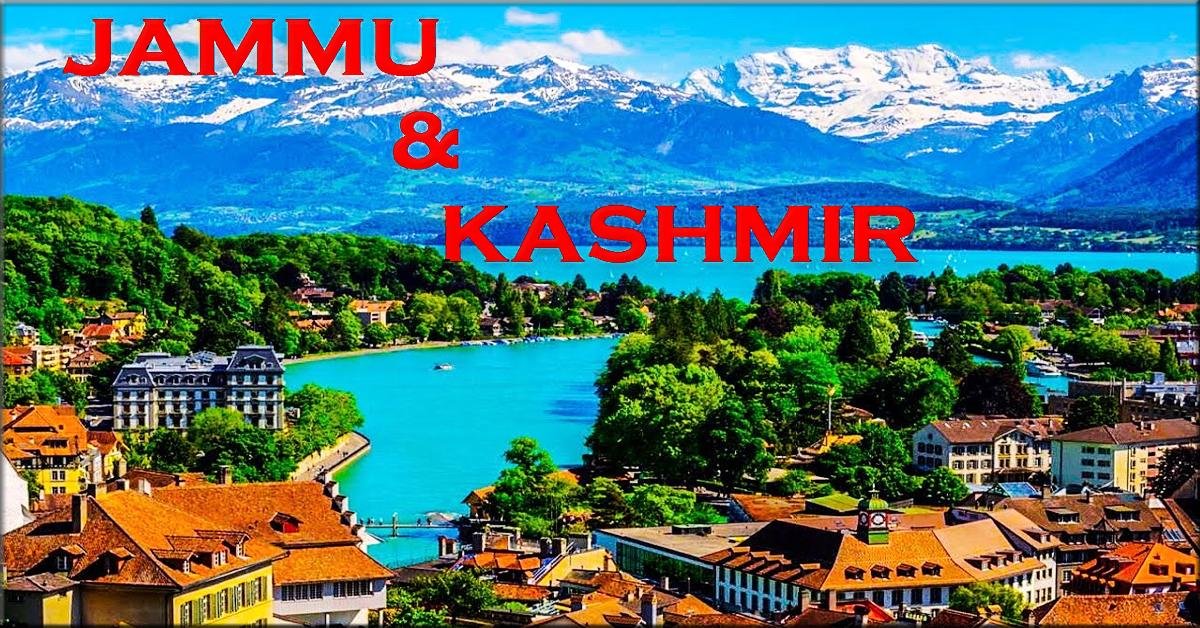Killed the Hindu king and married the beautiful princess. Who was the first Muslim ruler of Kashmir? How Islam spread in the valley
About 700 years ago, a young man approached Kashmir through the Zojira pass. He had a small group of soldiers with him. When Ramchandra, the commander of Kashmir’s Hindu king Sahadev, stopped him, he told his tale of woe. I am Prince Ranjan. My father died in the civil war in Tibet. I have somehow saved my life through the Sushila pass. Shelter me. Ramchandra told Ranjan about Kashmir. A famous Kashmiri historian, Prithvinath Kaul Bhanj, writes in his book History of Kashmir that in 1320 AD, General Mangal attacked Kashmir, and King Sahadev fled to Kishtwar without fighting. The procession caused a lot of uproar in Kashmir for 8 months. While returning, Ramchandra took over the rule of Kashmir, but then Tibetan refugee Prince Rinchen got an opportunity and had Ramchandra killed and himself boarded the Kashmiri train. He married Ramchandra’s beautiful daughter Kota. Prem considered himself a Buddhist Lama. Queen Kota wanted him to become a Hindu, but he converted to Islam. This is how Kashmir got its first Muslim rule. Special series related to the history, war, and politics of Kashmir. In this, we will know why Ranjan adopted Islam, how Kashmir was before that, and who liked Kashmir. There are three Takiya stories related to Kashmir’s gram flour; the first story is of Rishi Kashyap. According to Hindu mythology’s Neel Mat Purana, the Kashmir valley was earlier a huge lake named Satish, which was dried by Brahma’s grandson, Kashyap Rishi. Kashyap settled the entire area, which we now call Kashmir. The second story is Kashif, whose Sufi writer Khawaja Azam presented the Islamic form of this story by placing Kashif Zinc in the place of Kashyap Rishi in Kashmir in 1747. The third story is of a Buddhist named Madhyamik. According to the famous Chinese traveler Wei Insan, Buddha once said that a Buddhist would come to Kashmir and establish a state after his death. 50 years after Buddha’s death, Madhyantik went to Kashmir and dried the lake, and many Buddhists settled here. The first historical evidence of Kashmir is found in the excavation of Burj Ham,
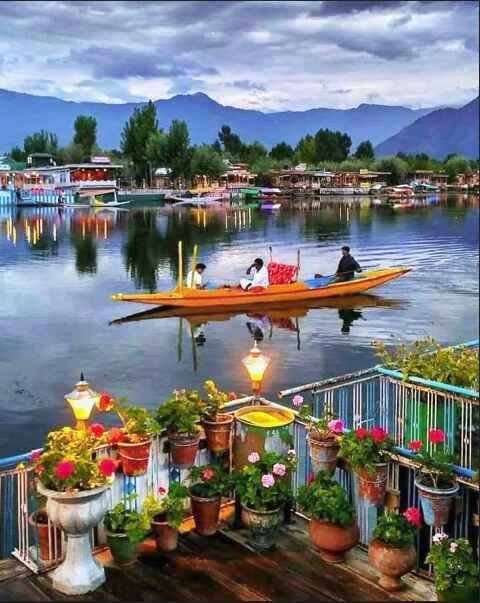
about 8 km from Srinagar, which shows that 3 to 5000 years ago, Earlier people used to live here, although there is no evidence of any organized religion. In history, Kashmir has been under the rule of different states at different times. In the beginning, Buddhist rulers like Emperor Ashoka ruled. After the seventh century, Hindu kings ruled, and from the 14th century, Muslim dynasties were established. To understand the history of Kashmir, it is very important to mention some famous kings. The rule of Lalit Aditya from 724 to 761 AD is considered to be the golden age of Kashmir. He fought wars for 14 years and could conquer Afghanistan, Punjab, Bihar, Bengal, and Orissa. According to the book Al Hind by Andhra Bank, Professor of Wisconsin University of America, Lalita Didi had also conquered a large part of the province of China. About two and a half hundred years later, i.e., between 1000 AD and 1027 AD, Mahmud Ghazni attacked India 17 times and looted it. During this time, his eyes were on Kashmir, and in 1015 AD, he attacked Kashmir for the first time through the Tosh Maidan pass. At that time, Kashmir was ruled by Sangram Raja. Ghazni’s army got stuck in a flood, along with wandering on difficult roads, and Ghazni had to return empty-handed. Similarly, in 1021 AD, he again attacked Kashmir but failed this time too. Subsequent Kashmiri kings kept getting weaker. Due to their pleasure-seeking, they had to mortgage their monarchy and crown to foreign traders. King Harshdev of the Utpal dynasty, who was the ruler of Kashmir from 1089 to 111 AD, became poor due to extravagant expenditure and debauchery. It is believed that, influenced by Islam, he abandoned idol worship and started breaking the idols, Hindu temples, and many other religious sites in Kashmir. Harshdev destroyed precious idols and looted temple treasures. Harshdev’s contemporary historian Kalhar called him Purush, i.e., Turk. In the beginning, we mentioned the Buddhist prince Rinchen, who came to Kashmir from Tibet, became the king of Kashmir, and accepted Islam, but why did he accept Islam? According to historians, the Buddhist king would not have received the recognition of the Kashmiri people. Author Ashok Kumar Pandey writes in his book Kashmir and Kashmir Pandit that because he was a Tibetan Buddhist, the Brahmins refused to initiate him. Rinson took advice from the Sufi saint Bulbul Shah. They together adopted Salam and sat on the throne of Kashmir in the name of Sultan Sadaruddin, and the first Muslim rule of Kashmir began. After that, Islam gained more ground in Kashmir. The most controversial rule in the history of Kashmir is believed to be that of Sultan Sikandar, the ruler of the Shani dynasty, who sat on the throne in 1389. Kashmiri scholar Premnath Bajaj considers his rule to be the darkest spot in the history of Kashmir. Historian Jonraj writes in Rajtarangini II that Sultan Sikandar, intoxicated with religion, converted a Brahmin named Suhag Bhatt to Islam, named him Sahabuddin and made him his chief advisor, and married his daughter. On the suggestion of Saifuddin, Sultan Sikandar ordered the conversion of Brahmins and scholars to Islam. However, when his son Zainul Abedin sat on the throne, he rebuilt the temples and tried to bring back the Brahmins who had left Kashmir. He was against Islamic fanaticism.
Aurangzeb did not like the clothes of Kashmiri women: Raja Gulab Singh bought Kashmir for ₹75 lakhs, the kingdom extended till Russia, part -2
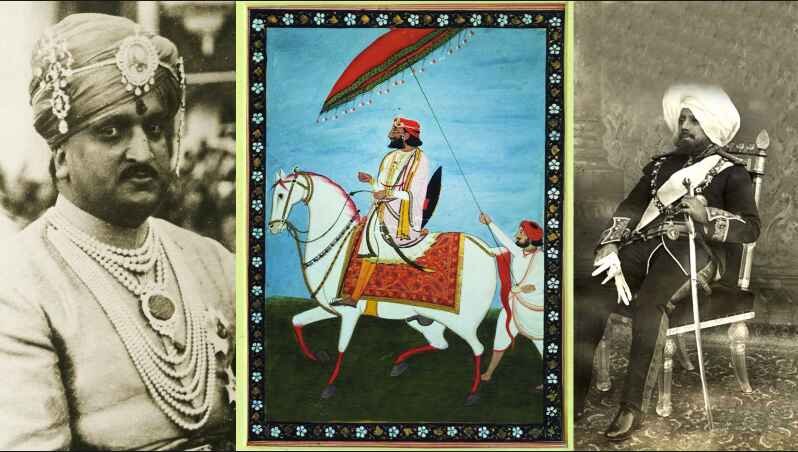
27 June 1839 Place Lahore Fort The funeral pyre of Maharaja Ranjit Singh of the Sikh Empire is kept on Maharani Mata Devi alias Guddan came out of the Haram barefoot with three queens, there was no veil on her face Author Sarvpreet Singh writes in his book VKML Merchant of Falade Piya that CDO climbed the pyre and sat at the head of Maharaja Ranjit Singh After a while, she sat at the feet of the queen along with slave girls Maharaja Kharak Singh set the pyre on fire with the last salute of 180 guns Ranjit Singh’s body along with his four queens and slave girls were also reduced to ashes The last rites are being performed in Lahore Fort 200 km away The fate of Jammu and Kashmir was about to change The entire story from the rule of King Akbar of the Mughal Empire on Kashmir to King Ranjit Singh of the Sikh Empire and the arrival of the British In 1579 AD, Yusuf Shahchak was going somewhere sitting on the carriage of Kashmir. On the way, Habba Khatoon, who was picking saffron in the fields, was singing a sad song in her tune. Ashok Kumar Pandey writes in his book Kashmir Naam that Yusuf Shah was mesmerized by the beauty of Habba and her voice and fell in love with her. She was the wife of a poor farmer. On the orders of Yusuf, she was immediately divorced from her, and she came to Srinagar as Habba Begum. There was a rebellion against Yusu,f who was immersed in music, poetry, and love, and he had to leave the carriage and run away. In 1580, Yusuf ran away and reached Akbar in Agra, and with the help of the Mughals, on the way to Kashmir, he met the full minister Mohammad Bhatt. Here, the intentions of both of them changed, and leaving the Mughals, they captured Kashmir again. Angered by this, Akbar sent troops and arrested Yusuf in 1586. On the orders of General Man Singh, he was sent to Bihar, and he died in 1592. His son also died in October 1593. After ending the Chak dynasty, Akbar annexed Kashmir to his empire and appointed a governor, and started running the administration there. The rule of the Mughal emperors Akbar, Jahangir, and Shah Jahan was mixed for Kashmir. In his book History of Muslim Rule in Kashmir, Mughal emperor Aurangzeb writes that he went to Kashmir only once during his tenure,e and his attention went to three things which he found anti-Islamic. Kashmiri women did not wear undergarments. Cultivation of opium and its use were common. Bhaand, colour, and facial acting were common. Aurangzeb declared all three as anti-Islamic. After this, the decline of the Mughals started, and Afghan Pathans controlled Kashmir. Kashmir was controlled by the Pathans till around 1819. Meanwhile, Maharaja Ranjit Singh was rapidly expanding the Sikh empire. He had the biggest power in the country at that time. He defeated the ruler of Kashmir, Jabbar Khan, and captured Kashmir. However, he gave the city of Jammu to Dogra Rajput Gulab Singh. In 1845, a war broke out between the East India Company and the Sikhs. Later, the Sikhs made a treaty proposal and gave Gulab Singh the role of mediator. The British demanded 1.5 crore rupees as compensation for the war expenses and a large part of Punjab. The court did not have that much money, so the hilly areas between the rivers Sindh and Indus were offered, which also included Kashmir. The British were not so interested in it because of the inaccessible mountainous area. Gulab Singh signed a treaty and bought Kashmir from the British for 75 lakh rupees. After this treaty, the present Jammu and Kashmir came into existence, and the Dogra rule began. After the death of Raja Gulab Singh in 1857, his sons Ranbir Singh and Ranveer were crowned. After this, on 12 September 1885, Ranveer Singh’s elder son Pratap Singh was crowned. Pratap expanded the boundaries of the state and included Gilgit’s Hunza Valley, Nagar, and Yasinwali in his kingdom. Now, the boundaries of Pratap’s kingdom started reaching Ras in the north. China did not accept the McMahon Line as the boundary between India and China in 1914, but a British officer named Henry McMahon did. China accepted the line, including Hamza of the Kashmir state. He claimed a large part of the territory, and the British officers, without any opposition, allowed his nephew Hari Singh to board the chariot in 1925. After Pratap Singh, Hari Singh was the last king of the Jammu and Kashmir state. During his tenure till 1937, China also claimed the Shaktang valley. In this way, a large part of the Kashmir state was occupied by China even before the country’s independence.
Jinnah was stopped from coming to Kashmir, then the massacre happened: The Indian army reached Lahore, was PoK created due to Nehru’s mistake? Is it possible to repeat history now?
On 24 August 1947, Mohammad Ali Jinnah sent his military secretary to Karnal, William Bharni, to Kashmir. Jinnah, tired of TV and Lux, wanted to rest for a few days in Kashmir. At that time, Kashmir was an independent state, and Jinnah hoped that Kashmir, with a 75% Muslim population, would join Pakistan. In his book Freedom at Midnight, after returning from Kashmir, Karnal Burney said that King Hari Singh of Jammu and Kashmir did not want Jinnah to set foot on the soil of Kashmir. He understood that the situation could be opposite to what he thought about Kashmir. Under the Indian Independence Act 1947, passed in the British Parliament on 18 July 1947, the country gained independence, but it was divided into two dominions, India and Pakistan. At that time, the 565 princely states in the country were given the option of joining either of the two countries or staying independent. Except for Junagadh, Hyderabad, and Kashmir, most of the princely states had joined India or Pakistan before 15 August 1947. Hari Singh had decided that Jammu and Kashmir would remain independent, and after independence would join India. No pressure was exerted on Kashmir to join India. Sardar Patel also did not want to get embroiled in the Kashmir issue. He believed that India already had the option of joining the Union. On 24 August 1947, Pakistan wrote a warning letter to Maharaja Hari Singh saying that the Maharaja of Kashmir should make his choice and choose Pakistan if Kashmir
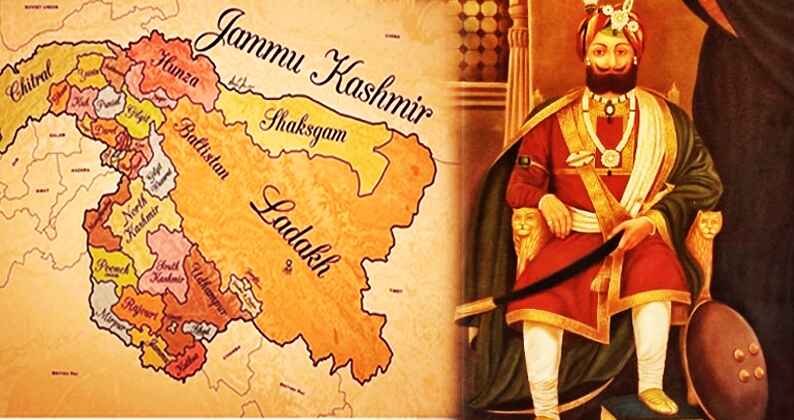
If Pakistan is not included, then there can be a big crisis. By September, complaints of infiltration from Pakistan started coming in from Kashmir. On 22 October 1947, about 5000 Pakistani Qawwalis came to Kashmir in trucks. They were being led by the soldiers of Pakistan. Chaudhary writes in his book Pakistan’s Siyasi Itihaas that for three days, the attackers massacred the non-Muslims and looted and burnt their houses. Thousands of women were raped and kidnapped. When the Pakistani Qawwalis started moving towards Srinagar on 24 October, Maharaja Hari Singh sought military help from India. In the presence of Prime Minister Nehru, Home and Defense Minister Sardar Vallabhbhai Patel, Governor General Lord Mountbatten, and British commanders of the three armies, the Indian Defense Committee sent BP Menon to Srinagar to visit Kashmir. He returned the same day and said that Kashmir should be sent immediately to save itself from the attackers. Meanwhile, on 26 October, Maharaja Hari Singh went from Srinagar to Jammu in search of a safe place and signed the merger letter of Kashmir with India and on the very next day of Kashmir’s joining India i.e. on 27 October 1947, Maharaja Hari Singh In the morning, Indian forces landed on Srinagar airstrip and the process of pushing back Pakistani troops began. The war lasted for one year, two months, and five days. On 1 January 1948, India raised the Kashmir issue in the United Nations Security Council. The ceasefire was announced on 1 January 1949. The part that was in India’s share remained with India, and the part that was in Pakistan remained with Pakistan. The boundary line in Kashmir was decided between the two countries, which was called the Line of Control or LOC. Nehru is criticized for raising the Kashmir issue in the United Nations Security Council. It is said that when our forces were winning in Kashmir, a ceasefire was declared. If the ceasefire had been delayed by 3 days, Pakistan-occupied Kashmir would have been with India. At that time, Indian forces were not in a very strong position. Indian Army Chief General Gurjar told Nehru that we should remain defensive. Gurjar agreed with Pakistan Army Chief General Gracey on 31 December 1948, and the ceasefire came into effect on 1 January 1949. Jammu and Kashmir and Ladakh remained in India, while Pakistan kept Gilgit under its control. Another part of Kashmir, which India calls POK, was later handed over to China by Pakistan. On 20 June 1949, Raja Hari Singh was formally removed from power, after which he went to Mumba, your Mumbai. He died here on 26 April 1961. Pakistan kept trying continuously to capture Kashmir. Operation Gibraltar was launched in 1965, after which the war of 1965 began. In 1999, an attempt was made to capture Kashmir through Kargil, but Pakistan lost every time.
Vajpayee was in Lahore, and the Pak Army entered Kargil: Pathankot attack on the 9th day of Modi’s Lahore visit; How much has Kashmir changed after the removal of 370
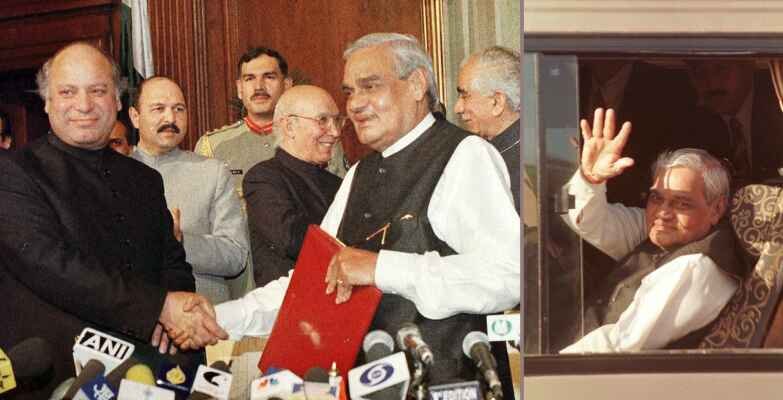
On the evening of 7th July 2016, news came from an army camp in Kashmir that Hizbul commander Burhan Wani was in a house in Bandura village near Panipat. 22-year-old Burhan Wani had become the poster boy of Kashmir. Burhan combined glamour with guns. His posters used to go viral on social media. He had recruited dozens of youths in Hizbul. The army was also looking for him near Kokar Nath. When Barhan’s location was confirmed, the army started an operation to capture him with 100 soldiers and 35-36 police SOG soldiers. Terrorists Sartaj and Parvez were also in the house with Barhan. When they got the hint, Sartaj and Burhan opened fire on him. The army started retaliatory action, and the operation was completed in only 15 minutes. Burhan Wani, along with his two companions, was killed. This was not an ordinary incident. Burhan’s encounter rekindled the fire in Kashmir. The fifth part of the Kashmir Ki Kahani series and the last episode is about the stories of the big upheaval in Kashmir from Prime Minister Vajpayee to Modi and further. By 1998, both India and Pakistan had become nuclear powers. The then Prime Minister Atal Bihari Vajpayee wanted peace should be maintained with Pakistan. In December of the same year, Vajpayee met Pakistan Prime Minister Nawaz Sharif in New York during the United Nations meeting. It was here that the foundation of the Lahore bus journey was laid. Vajpayee went to Lahore by bus on 19 February 1999. This was the first Delhi-Lahore journey. Here, PM Vajpayee and Nawaz Sharif signed the Lahore Agreement for peace in Kashmir and between the two countries. On one hand, Nawaz was hugging for friendship, and on the other hand, he was also preparing to conquer Kashmir. About 3 months after meeting Vajpayee, Nawaz Sharif started making a plan to capture Kashmir from this and Park C. On 17 May 1999, the progress report of this plan was presented in his office, a few miles away from Islamabad. The report was uploaded on the mobile of Sartaj, the foreign minister in the Nawaz government. Aziz reminded Nawaz that this would be a violation of the Lahore Agreement, but Nawaz clearly said that we have to do this for the water of Kashmir. Nawaz worked on the plan, and Pakistan captured some areas of Kargil. After this, Indian forces withdrew their share in the Kargil war. There was no dialogue between the two countries for a long time after the Kargil war. In October 1999, the Pakistan government toppled the government, and General Musharraf became the President. One day, India sent a proposal for peace talks to Pakistan. After this, he came to change the image of Pakistan at the beginning of the summit in Agra from 14 to 16 July 2001, but what he said about Kashmir worsened the situation. Ajay Bisaria, who was Pakistan’s ambassador to India, in his book Anger Management, wrote about a troublesome diplomatic relationship between India and Pakistan. On the second day of the summit, Musharraf met the editors of the country’s leading newspapers and TV channels and said that the people who have taken up arms in Kashmir are not terrorists but freedom fighters. People in Kashmir are fighting for freedom. All this was going on live, but when they were informed about this statement of Musharraf, they were shocked. When he came to know about the matter, he clearly said that India will not make any compromise on the Kashmir issue. After this, Musharraf left the Agra summit incomplete and went to Pakistan. After Atal Bihari Vajpayee, for 10 years, the Manmohan Singh government did not take any steps like the Vajpayee government for peace talks. During this period, terrorism from Pakistan’s side continued to flourish in Kashmir. Narendra Modi became the Prime Minister in 2014. He took the initiative to improve relations with Pakistan. Pakistan’s then-Prime Minister Nawaz Sharif also attended his swearing-in ceremony. On 25 December 2015, PM Modi was on a visit to Afghanistan. According to the program, he had to land directly in Delhi while returning, but at exactly 1:31 in the afternoon, he tweeted that he was going to meet Pakistan’s PM Nawaz Sharif in Lahore. This tweet caught the attention of the whole world. After 11 years, an Indian PM was going to Pakistan, that too suddenly at 4:00 in the evening. PM Modi planned to land in Lahore. Modi reached Namaz’s house in a helicopter from Pakistan and stayed in Pakistan for about two and a half hours. Before this, no Prime Minister of India had sat in a helicopter from Pakistan. This step by Modi is a new step for the relations between the two countries. It was seen as a beginning, but in January 2016, there was a terrorist attack on the Pathankot air base, which again halted the dialogue between India and Pakistan. In 2015, after the Jammu and Kashmir assembly elections, the BJP formed the government in alliance with the PDP. Mufti Mohammad Shahid became the Chief Minister. After his death on 7 January 2016, Mehbooba Mufti became the Chief Minister. Mufti’s decisions in many cases went against the BJP. In such a situation, in June 2018, the BJP withdrew support. Mehbooba’s government fell, and President’s rule was imposed in Kashmir. There was an atmosphere of the 2019 Lok Sabha elections in the country.On 14 February, there was a terrorist attack on a CRPF convoy in Pulwama in which 40 soldiers were martyred. Exactly 12 days after the attack, on 26 February 2019, the Indian Air Force bombed the Lok Parker Chest bases, in which about 300 terrorists were killed. After winning the 2019 Lok Sabha elections, the Modi government took a historic decision. The government gradually prepared and on 5 August 2019, abolished Article 370 from Jammu and Kashmir. With this, the state was divided into Jammu, Kashmir, and Ladakh. Now, after 10 years, assembly elections are going to be held again in Jammu and Kashmir, although the threat of terrorism is still not averted.
The Kashmiri state extended to Russia. Today, there are 8 parts of Jammu and Kashmir; 30% land is occupied by Pakistan, 10% by China
If I say that about 125 years ago, the map of Kashmir was something like this, you might not believe it. Still, it is true because 125 years ago, the border of Jammu and Kashmir was with Soviet Russia before independence, and in the next 25 years, Jammu and Kashmir was divided into eight parts; India has only 60% area, Pakistan occupies 30% land, and China holds 10%.
Initially, Kashmir was ruled by different Hindu kings. Kashmir got its first Muslim ruler in Chaudhary Sari. Till the end of the 16th century, the Mughals ruled Kashmir. After this, in 1819, Maharaja Ranjit Singh included Kashmir in the Sikh Empire. After the death of Ranjit Singh in 1839, Sikhs offered a treaty to the British, and seeing the opportunity, Raja Gulab Singh Dogra bought Kashmir for 75 lakh rupees. On 6 March 1846, the Treaty of Amritsar was signed. Gulab Singh made Kashmir the head of the British and the king of the state of Jammu and Kashmir. From here, the present Jammu and Kashmir came into existence. The boundary of Jammu and Kashmir was Gilgit, Hunza Nagar Chitral, spread from the Hindu Kush mountains in the north to the plains of Jammu in the south. According to Manohar Parikar, Director General of the Institute for Defence Studies and Analysis, in 1914, British officer Henry McMahon drew a McMahon line to determine the border between India and China. Tibet accepted it, but China did not accept it and rejected it. In this way, a large part of the state of Kashmir went into the hands of China even before the independence of country. India gained independence in 1947, but Pakistan was also formed. Both countries wanted Kashmir to come to their side, but the king of the state, Hari Singh, wanted a separate country. In October 1947, when Pakistani soldiers and Qawwali fighters attacked, Hari Singh agreed to the merger of Jammu and Kashmir with India.
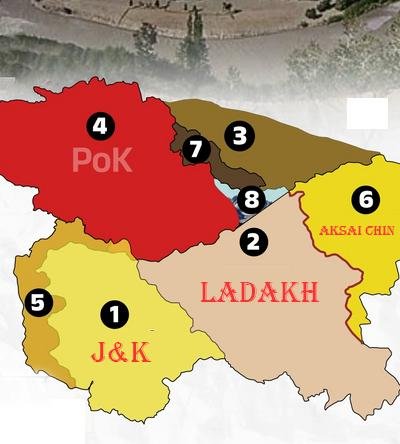
After the intervention of the United Nations, a ceasefire was declared in December 1948. At that time, 78000 square kilometers, about 30% of the area, was occupied by Pakistan. Pakistan calls the 13.3 km area of Pakistan as Azad Kashmir. After this war, a ground fire line was also drawn, which was converted into the Line of Control in 1972. After capturing Tibet in 1950, China built a road from Aksai Chin. India got information about the road built in 1956 after one year, and in 1962, China waged a war against India. In this, China captured Aksai Chin. The Line of Actual Control was drawn between the two countries. The next year, Pakistan handed over the Saksham Valley of Pakistan to China as a trophy to increase its proximity with China. In August 2019, the Modi government abolished Article 370 and the special status of Jammu and Kashmir from Jammu and Kashmir. Now, through this map, we understand the eight parts of the state of Jammu and Kashmir at present. This first part is the Union Territory of Jammu and Kashmir, which is part of India. The second visible part is the Union Territory of Ladakh, which is part of India. This third part is the part of the Jammu and Kashmir state that was occupied by the British before 1947. The fourth part was given to Pakistan, Pak is the area occupied by Pakistan, the fifth part is the small part of Pok which Pakistan calls Azad Kashmir, this is the sixth part which was occupied by China in the 1962 war, these seven brothers were occupied in the 1962 war, in 1963 a small part of PoK was illegally given to China by Pakistan and this eighth part is the Siachen Glacier which is part of India, infiltration takes place in different parts of Kashmir from these, according to video reports, most of the infiltration takes place from Guwahati, Kandahar Sector 5 and Rajouri adjacent to Pak, according to retired Lieutenant General PC Torch, every year due to snowfall, avalanche etc., about 300 to 400 km of fencing gets damaged in Jammu and Kashmir, which is taken advantage of by terrorists, it is being equipped with many types of alarm sensors and anti-entry technology so that terrorists and infiltrators stay away from the land of Jammu and Kashmir.
